International Marketing: Market Selection and Entry Strategy
VerifiedAdded on 2023/03/31
|9
|2671
|123
AI Summary
This report explores the process of international marketing and focuses on the market selection and entry strategy. It evaluates the conditions of different countries and recommends the best country for launching a product. It also discusses the advantages of online distribution strategy.
Contribute Materials
Your contribution can guide someone’s learning journey. Share your
documents today.
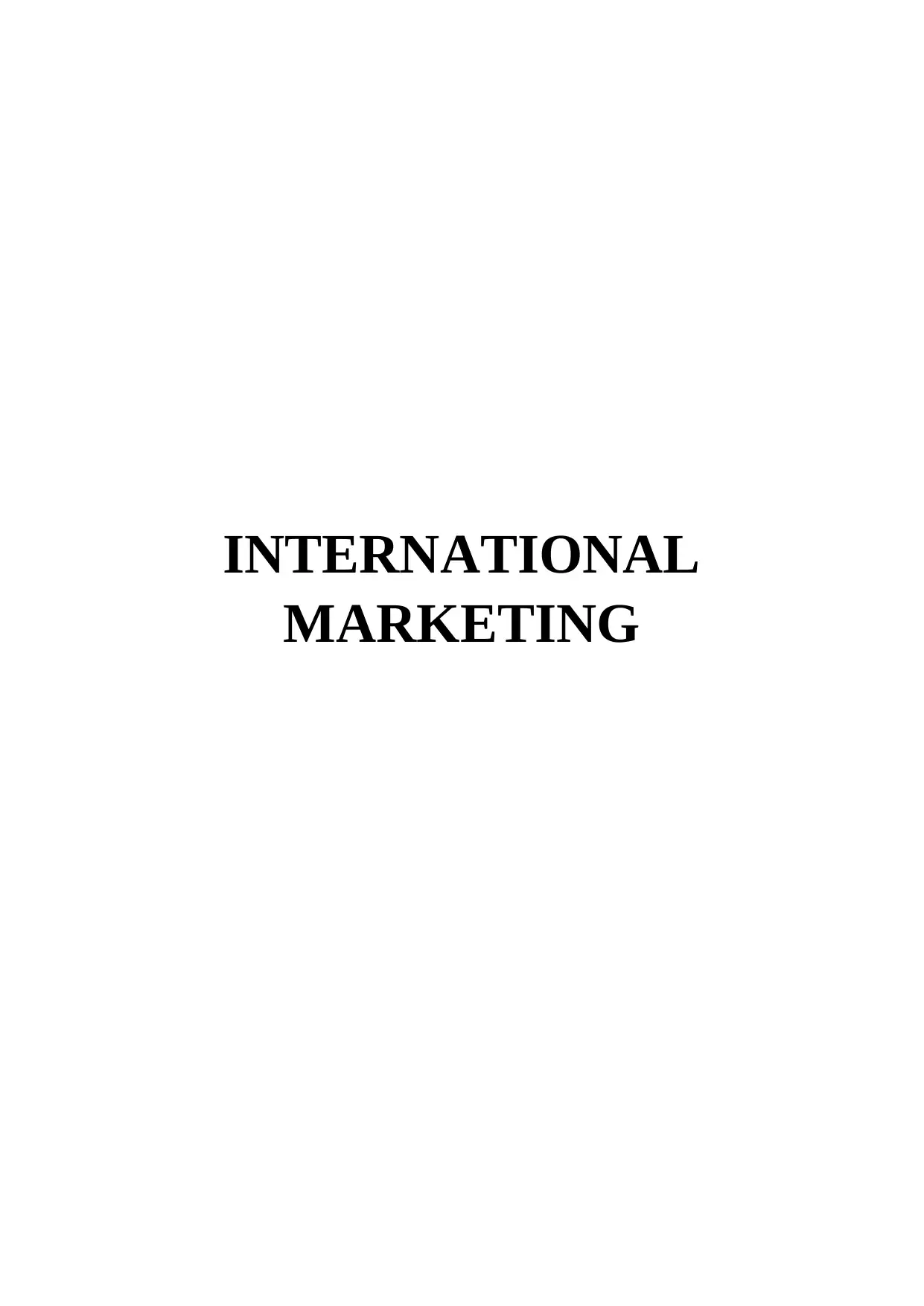
INTERNATIONAL
MARKETING
MARKETING
Secure Best Marks with AI Grader
Need help grading? Try our AI Grader for instant feedback on your assignments.

Table of Contents
INTRODUCTION....................................................................................................................4
TASK A.....................................................................................................................................4
Market selection.....................................................................................................................4
TASK B.....................................................................................................................................7
Market entry and distribution strategy...................................................................................7
CONCLUSION.........................................................................................................................8
REFERENCES.........................................................................................................................9
INTRODUCTION....................................................................................................................4
TASK A.....................................................................................................................................4
Market selection.....................................................................................................................4
TASK B.....................................................................................................................................7
Market entry and distribution strategy...................................................................................7
CONCLUSION.........................................................................................................................8
REFERENCES.........................................................................................................................9

INTRODUCTION
International marketing is a process that takes place outside the national
boundaries for creating a market that helps in satisfying the objectives of the business and of
the individuals, the international marketing said to focus the resources on the global market.
Globalisation has open the doors to enter any market of your choice and businessmen can run
their business outside their domestic boundaries( Berthon Plangger and Shapiro 2012).
Globalisation has re moved the barriers of boundaries. Here in this report Peppersmith’s
expansion in international market has been explored. The peppersmith make candies named
TINGZ and these are approved by the dentists and these are used by most of the schools to
fed the children as it is sugar free and does not causes cavities. This report presents the
application of the process and the entry of the foreign market and their mode of selection.
Assessment of the process and practice of market development planning will be applied in the
present report.
TASK A
Market selection
The Peppersmith wanted to enter into the international market and launch their
product Tingz , which contains Xylitol (it is a sugar substitute and has no negative impact).
For selecting the market there are screening criteria to see before entering the international
market(Cheng Kotler and Lee 2011). The countries should be judged on these criteria and
then ranking must be done and afterward business should enter that market.
Country Market
deman
d
Country
performanc
e
Trade
barriers
Political
risk
Technologic
al
advancement
Cultural
knowledge
Holland 18th
largest
econo
my in
the
world
$48,860
GDP
termed as
the richest
nations in
the world
No trade
barriers.
Its an
open
economy
safe Highly
educated
people and
technologica
l
advancement
Specific and
concise
Germany 4th
largest
econo
my in
the
world
Strict
safety
regulation
s
Safe and
stable
Very
advanced in
technology,
Industrial
sector is
strong
Educated
population
with high
living
standards
Japan 3rd
highest
econo
my
GDP at
$37,519
Strict Stable but
having
conflicts
with
neighbourin
g countries
They are
known for
their
technology
People are
known for
their
professionlis
m
Czech
Republic
GBP
22900
European
standards
No political
risk
Good
standard of
technology
People are
easy going
and talkative
International marketing is a process that takes place outside the national
boundaries for creating a market that helps in satisfying the objectives of the business and of
the individuals, the international marketing said to focus the resources on the global market.
Globalisation has open the doors to enter any market of your choice and businessmen can run
their business outside their domestic boundaries( Berthon Plangger and Shapiro 2012).
Globalisation has re moved the barriers of boundaries. Here in this report Peppersmith’s
expansion in international market has been explored. The peppersmith make candies named
TINGZ and these are approved by the dentists and these are used by most of the schools to
fed the children as it is sugar free and does not causes cavities. This report presents the
application of the process and the entry of the foreign market and their mode of selection.
Assessment of the process and practice of market development planning will be applied in the
present report.
TASK A
Market selection
The Peppersmith wanted to enter into the international market and launch their
product Tingz , which contains Xylitol (it is a sugar substitute and has no negative impact).
For selecting the market there are screening criteria to see before entering the international
market(Cheng Kotler and Lee 2011). The countries should be judged on these criteria and
then ranking must be done and afterward business should enter that market.
Country Market
deman
d
Country
performanc
e
Trade
barriers
Political
risk
Technologic
al
advancement
Cultural
knowledge
Holland 18th
largest
econo
my in
the
world
$48,860
GDP
termed as
the richest
nations in
the world
No trade
barriers.
Its an
open
economy
safe Highly
educated
people and
technologica
l
advancement
Specific and
concise
Germany 4th
largest
econo
my in
the
world
Strict
safety
regulation
s
Safe and
stable
Very
advanced in
technology,
Industrial
sector is
strong
Educated
population
with high
living
standards
Japan 3rd
highest
econo
my
GDP at
$37,519
Strict Stable but
having
conflicts
with
neighbourin
g countries
They are
known for
their
technology
People are
known for
their
professionlis
m
Czech
Republic
GBP
22900
European
standards
No political
risk
Good
standard of
technology
People are
easy going
and talkative

Netherland (Holland):
The IMF ranked Holland as the 18th largest economy in the world. Its GDP is $48860
and is the richest nations. It has an open economy and its economy depends on foreign trade
so there are no such trade barriers, it has low inflation and low unemployment. The current
account surplus of Netherlands is more than Germany(Chung Wang and Huang 2012). The
political conditions of Netherlands have democratic government.
The economy of Netherlands is very open and relies in international trades mostly.
Their policies on recreational drugs, same-sex marriage, abortion, etc. are among the most
liberal in the world.
The crime rate in Netherlands is declining at such a rate that they have to close 19 Dutch
jails.
Trade wise(Coviello McDougall and Oviatt2011), their depth of experience in trade,
positions them as the genuine “neutral” traders of Europe.
Economically the Netherlands has an advanced, prosperous, outward-looking economy.
The industrial relations are very stable, not much affected by the inflation and the
distribution of the income is even.
Netherlands is well known for its highly educated and flexible workforce. Also, the Dutch
people are one of the most multilingual in the world.
Although being in size, the Netherlands is one of the world's ten leading exporting nations.
The manufacturing sector is not the main USP of Netherlands but it is very well diversified. It
includes the manufacturing of process food, tobacco, beverages and metal products.
Netherlands is very popular with the foreign companies because of the openness in their
economy. The introduction of the FDI has helped a lot to the multinational companies. Some
of the examples are Shell oil(Czinkota and Ronkainen 2013), Unilever, Philips, Heineken, etc.
Technology wise, they are expertise in electronically controlled machinery. Due to this they
have become the world’s leader in the food processing equipment.
The Dutch are global in their outlook and generally welcome opportunities for foreign
cooperation.
Cultural
Dutch society revolves around hard facts and statistics, so presentations and speeches
which contain sweeping generalisations and over-simplifications will not help sell your idea
or product to a Dutch audience(Czinkota Ronkainen and Zvobgo 2011). Being specific and
concise will.
GERMANY
Germany is well known for its export capabilities. The country is a leading exporter
of machinery, vehicles, chemical and households. Persistent but reducing backwardness of
eastern Länder. Germany is the fourth largest economy in the world and the biggest in the
The IMF ranked Holland as the 18th largest economy in the world. Its GDP is $48860
and is the richest nations. It has an open economy and its economy depends on foreign trade
so there are no such trade barriers, it has low inflation and low unemployment. The current
account surplus of Netherlands is more than Germany(Chung Wang and Huang 2012). The
political conditions of Netherlands have democratic government.
The economy of Netherlands is very open and relies in international trades mostly.
Their policies on recreational drugs, same-sex marriage, abortion, etc. are among the most
liberal in the world.
The crime rate in Netherlands is declining at such a rate that they have to close 19 Dutch
jails.
Trade wise(Coviello McDougall and Oviatt2011), their depth of experience in trade,
positions them as the genuine “neutral” traders of Europe.
Economically the Netherlands has an advanced, prosperous, outward-looking economy.
The industrial relations are very stable, not much affected by the inflation and the
distribution of the income is even.
Netherlands is well known for its highly educated and flexible workforce. Also, the Dutch
people are one of the most multilingual in the world.
Although being in size, the Netherlands is one of the world's ten leading exporting nations.
The manufacturing sector is not the main USP of Netherlands but it is very well diversified. It
includes the manufacturing of process food, tobacco, beverages and metal products.
Netherlands is very popular with the foreign companies because of the openness in their
economy. The introduction of the FDI has helped a lot to the multinational companies. Some
of the examples are Shell oil(Czinkota and Ronkainen 2013), Unilever, Philips, Heineken, etc.
Technology wise, they are expertise in electronically controlled machinery. Due to this they
have become the world’s leader in the food processing equipment.
The Dutch are global in their outlook and generally welcome opportunities for foreign
cooperation.
Cultural
Dutch society revolves around hard facts and statistics, so presentations and speeches
which contain sweeping generalisations and over-simplifications will not help sell your idea
or product to a Dutch audience(Czinkota Ronkainen and Zvobgo 2011). Being specific and
concise will.
GERMANY
Germany is well known for its export capabilities. The country is a leading exporter
of machinery, vehicles, chemical and households. Persistent but reducing backwardness of
eastern Länder. Germany is the fourth largest economy in the world and the biggest in the
Secure Best Marks with AI Grader
Need help grading? Try our AI Grader for instant feedback on your assignments.
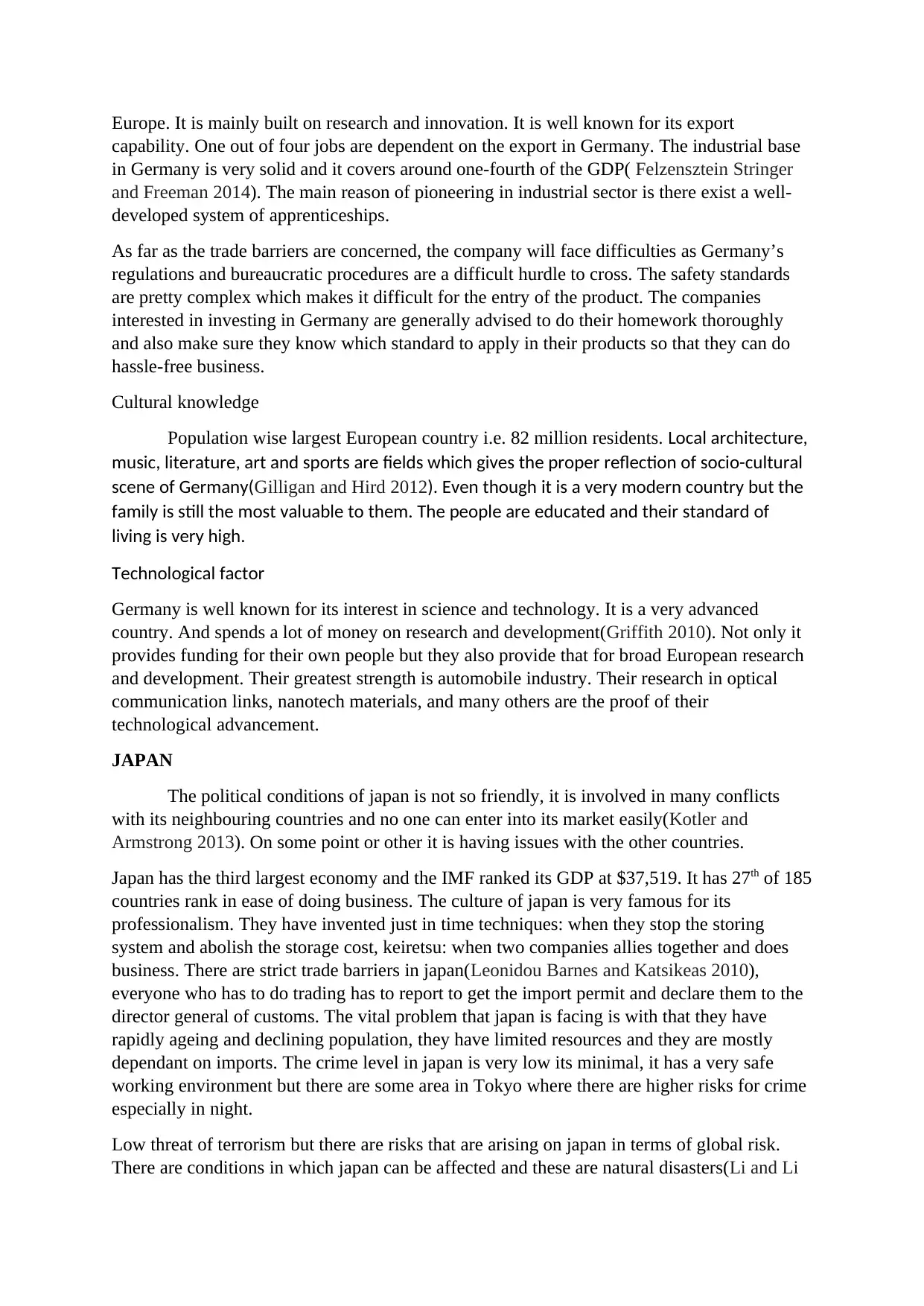
Europe. It is mainly built on research and innovation. It is well known for its export
capability. One out of four jobs are dependent on the export in Germany. The industrial base
in Germany is very solid and it covers around one-fourth of the GDP( Felzensztein Stringer
and Freeman 2014). The main reason of pioneering in industrial sector is there exist a well-
developed system of apprenticeships.
As far as the trade barriers are concerned, the company will face difficulties as Germany’s
regulations and bureaucratic procedures are a difficult hurdle to cross. The safety standards
are pretty complex which makes it difficult for the entry of the product. The companies
interested in investing in Germany are generally advised to do their homework thoroughly
and also make sure they know which standard to apply in their products so that they can do
hassle-free business.
Cultural knowledge
Population wise largest European country i.e. 82 million residents. Local architecture,
music, literature, art and sports are fields which gives the proper reflection of socio-cultural
scene of Germany(Gilligan and Hird 2012). Even though it is a very modern country but the
family is still the most valuable to them. The people are educated and their standard of
living is very high.
Technological factor
Germany is well known for its interest in science and technology. It is a very advanced
country. And spends a lot of money on research and development(Griffith 2010). Not only it
provides funding for their own people but they also provide that for broad European research
and development. Their greatest strength is automobile industry. Their research in optical
communication links, nanotech materials, and many others are the proof of their
technological advancement.
JAPAN
The political conditions of japan is not so friendly, it is involved in many conflicts
with its neighbouring countries and no one can enter into its market easily(Kotler and
Armstrong 2013). On some point or other it is having issues with the other countries.
Japan has the third largest economy and the IMF ranked its GDP at $37,519. It has 27th of 185
countries rank in ease of doing business. The culture of japan is very famous for its
professionalism. They have invented just in time techniques: when they stop the storing
system and abolish the storage cost, keiretsu: when two companies allies together and does
business. There are strict trade barriers in japan(Leonidou Barnes and Katsikeas 2010),
everyone who has to do trading has to report to get the import permit and declare them to the
director general of customs. The vital problem that japan is facing is with that they have
rapidly ageing and declining population, they have limited resources and they are mostly
dependant on imports. The crime level in japan is very low its minimal, it has a very safe
working environment but there are some area in Tokyo where there are higher risks for crime
especially in night.
Low threat of terrorism but there are risks that are arising on japan in terms of global risk.
There are conditions in which japan can be affected and these are natural disasters(Li and Li
capability. One out of four jobs are dependent on the export in Germany. The industrial base
in Germany is very solid and it covers around one-fourth of the GDP( Felzensztein Stringer
and Freeman 2014). The main reason of pioneering in industrial sector is there exist a well-
developed system of apprenticeships.
As far as the trade barriers are concerned, the company will face difficulties as Germany’s
regulations and bureaucratic procedures are a difficult hurdle to cross. The safety standards
are pretty complex which makes it difficult for the entry of the product. The companies
interested in investing in Germany are generally advised to do their homework thoroughly
and also make sure they know which standard to apply in their products so that they can do
hassle-free business.
Cultural knowledge
Population wise largest European country i.e. 82 million residents. Local architecture,
music, literature, art and sports are fields which gives the proper reflection of socio-cultural
scene of Germany(Gilligan and Hird 2012). Even though it is a very modern country but the
family is still the most valuable to them. The people are educated and their standard of
living is very high.
Technological factor
Germany is well known for its interest in science and technology. It is a very advanced
country. And spends a lot of money on research and development(Griffith 2010). Not only it
provides funding for their own people but they also provide that for broad European research
and development. Their greatest strength is automobile industry. Their research in optical
communication links, nanotech materials, and many others are the proof of their
technological advancement.
JAPAN
The political conditions of japan is not so friendly, it is involved in many conflicts
with its neighbouring countries and no one can enter into its market easily(Kotler and
Armstrong 2013). On some point or other it is having issues with the other countries.
Japan has the third largest economy and the IMF ranked its GDP at $37,519. It has 27th of 185
countries rank in ease of doing business. The culture of japan is very famous for its
professionalism. They have invented just in time techniques: when they stop the storing
system and abolish the storage cost, keiretsu: when two companies allies together and does
business. There are strict trade barriers in japan(Leonidou Barnes and Katsikeas 2010),
everyone who has to do trading has to report to get the import permit and declare them to the
director general of customs. The vital problem that japan is facing is with that they have
rapidly ageing and declining population, they have limited resources and they are mostly
dependant on imports. The crime level in japan is very low its minimal, it has a very safe
working environment but there are some area in Tokyo where there are higher risks for crime
especially in night.
Low threat of terrorism but there are risks that are arising on japan in terms of global risk.
There are conditions in which japan can be affected and these are natural disasters(Li and Li
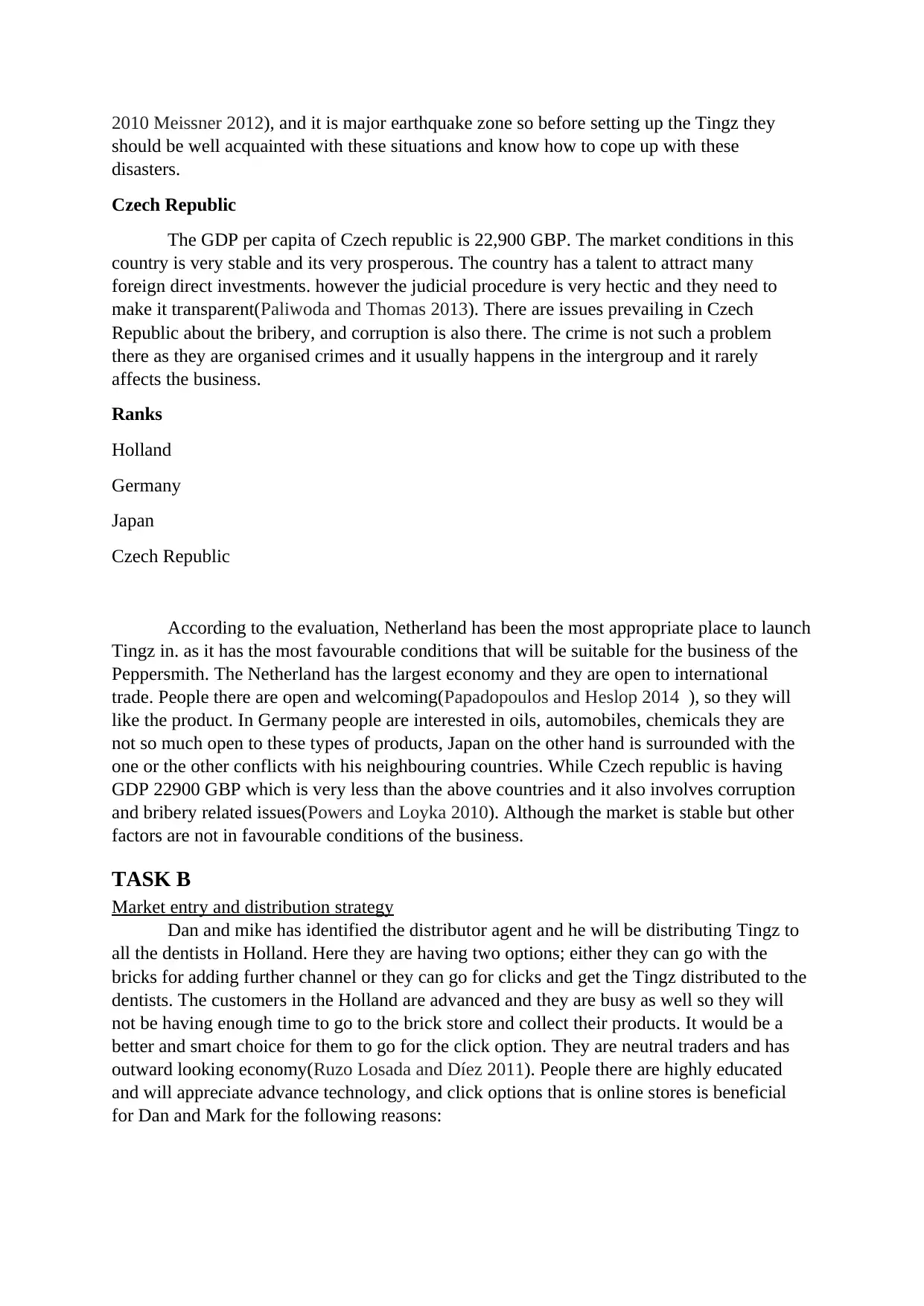
2010 Meissner 2012), and it is major earthquake zone so before setting up the Tingz they
should be well acquainted with these situations and know how to cope up with these
disasters.
Czech Republic
The GDP per capita of Czech republic is 22,900 GBP. The market conditions in this
country is very stable and its very prosperous. The country has a talent to attract many
foreign direct investments. however the judicial procedure is very hectic and they need to
make it transparent(Paliwoda and Thomas 2013). There are issues prevailing in Czech
Republic about the bribery, and corruption is also there. The crime is not such a problem
there as they are organised crimes and it usually happens in the intergroup and it rarely
affects the business.
Ranks
Holland
Germany
Japan
Czech Republic
According to the evaluation, Netherland has been the most appropriate place to launch
Tingz in. as it has the most favourable conditions that will be suitable for the business of the
Peppersmith. The Netherland has the largest economy and they are open to international
trade. People there are open and welcoming(Papadopoulos and Heslop 2014 ), so they will
like the product. In Germany people are interested in oils, automobiles, chemicals they are
not so much open to these types of products, Japan on the other hand is surrounded with the
one or the other conflicts with his neighbouring countries. While Czech republic is having
GDP 22900 GBP which is very less than the above countries and it also involves corruption
and bribery related issues(Powers and Loyka 2010). Although the market is stable but other
factors are not in favourable conditions of the business.
TASK B
Market entry and distribution strategy
Dan and mike has identified the distributor agent and he will be distributing Tingz to
all the dentists in Holland. Here they are having two options; either they can go with the
bricks for adding further channel or they can go for clicks and get the Tingz distributed to the
dentists. The customers in the Holland are advanced and they are busy as well so they will
not be having enough time to go to the brick store and collect their products. It would be a
better and smart choice for them to go for the click option. They are neutral traders and has
outward looking economy(Ruzo Losada and Díez 2011). People there are highly educated
and will appreciate advance technology, and click options that is online stores is beneficial
for Dan and Mark for the following reasons:
should be well acquainted with these situations and know how to cope up with these
disasters.
Czech Republic
The GDP per capita of Czech republic is 22,900 GBP. The market conditions in this
country is very stable and its very prosperous. The country has a talent to attract many
foreign direct investments. however the judicial procedure is very hectic and they need to
make it transparent(Paliwoda and Thomas 2013). There are issues prevailing in Czech
Republic about the bribery, and corruption is also there. The crime is not such a problem
there as they are organised crimes and it usually happens in the intergroup and it rarely
affects the business.
Ranks
Holland
Germany
Japan
Czech Republic
According to the evaluation, Netherland has been the most appropriate place to launch
Tingz in. as it has the most favourable conditions that will be suitable for the business of the
Peppersmith. The Netherland has the largest economy and they are open to international
trade. People there are open and welcoming(Papadopoulos and Heslop 2014 ), so they will
like the product. In Germany people are interested in oils, automobiles, chemicals they are
not so much open to these types of products, Japan on the other hand is surrounded with the
one or the other conflicts with his neighbouring countries. While Czech republic is having
GDP 22900 GBP which is very less than the above countries and it also involves corruption
and bribery related issues(Powers and Loyka 2010). Although the market is stable but other
factors are not in favourable conditions of the business.
TASK B
Market entry and distribution strategy
Dan and mike has identified the distributor agent and he will be distributing Tingz to
all the dentists in Holland. Here they are having two options; either they can go with the
bricks for adding further channel or they can go for clicks and get the Tingz distributed to the
dentists. The customers in the Holland are advanced and they are busy as well so they will
not be having enough time to go to the brick store and collect their products. It would be a
better and smart choice for them to go for the click option. They are neutral traders and has
outward looking economy(Ruzo Losada and Díez 2011). People there are highly educated
and will appreciate advance technology, and click options that is online stores is beneficial
for Dan and Mark for the following reasons:
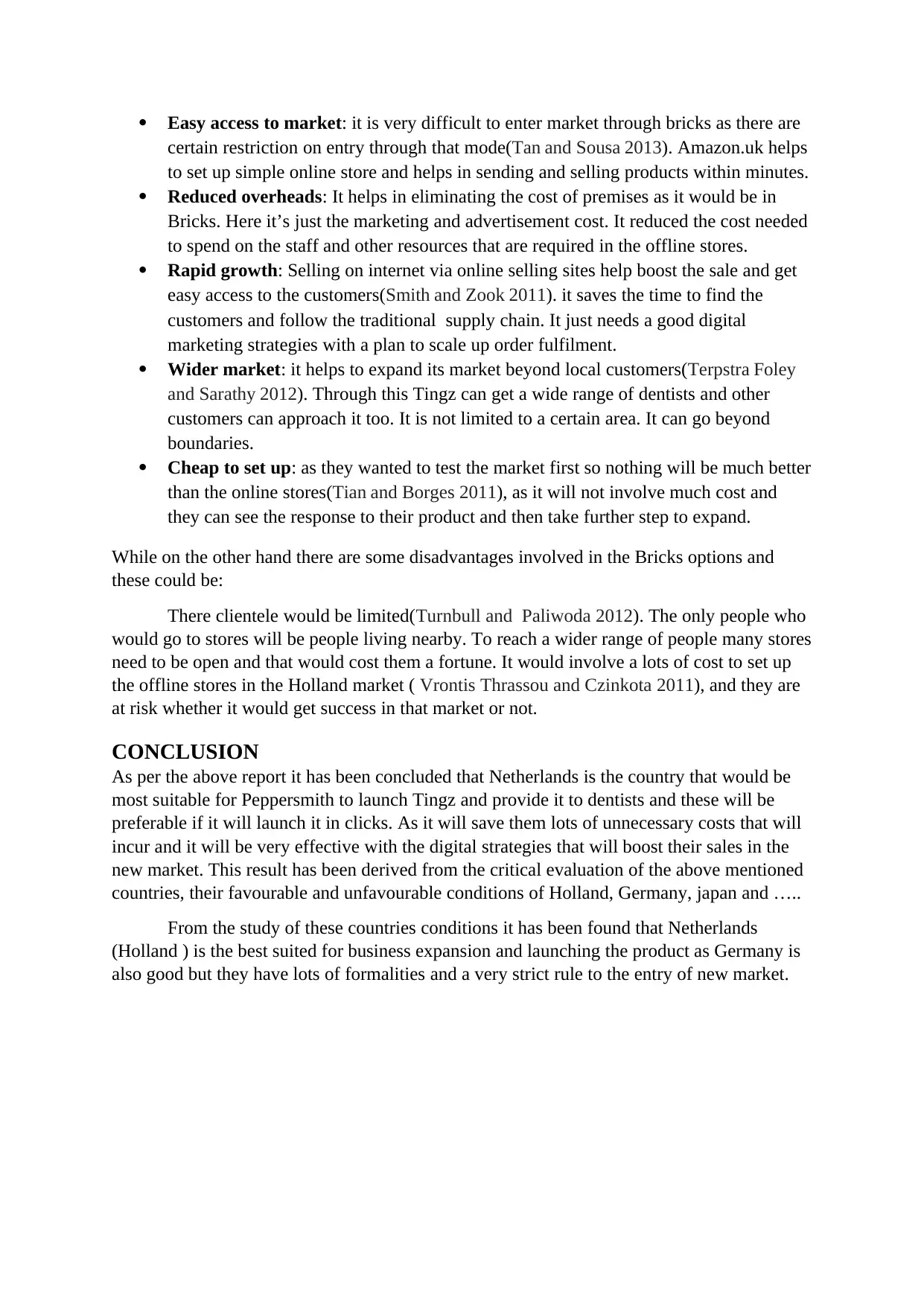
Easy access to market: it is very difficult to enter market through bricks as there are
certain restriction on entry through that mode(Tan and Sousa 2013). Amazon.uk helps
to set up simple online store and helps in sending and selling products within minutes.
Reduced overheads: It helps in eliminating the cost of premises as it would be in
Bricks. Here it’s just the marketing and advertisement cost. It reduced the cost needed
to spend on the staff and other resources that are required in the offline stores.
Rapid growth: Selling on internet via online selling sites help boost the sale and get
easy access to the customers(Smith and Zook 2011). it saves the time to find the
customers and follow the traditional supply chain. It just needs a good digital
marketing strategies with a plan to scale up order fulfilment.
Wider market: it helps to expand its market beyond local customers(Terpstra Foley
and Sarathy 2012). Through this Tingz can get a wide range of dentists and other
customers can approach it too. It is not limited to a certain area. It can go beyond
boundaries.
Cheap to set up: as they wanted to test the market first so nothing will be much better
than the online stores(Tian and Borges 2011), as it will not involve much cost and
they can see the response to their product and then take further step to expand.
While on the other hand there are some disadvantages involved in the Bricks options and
these could be:
There clientele would be limited(Turnbull and Paliwoda 2012). The only people who
would go to stores will be people living nearby. To reach a wider range of people many stores
need to be open and that would cost them a fortune. It would involve a lots of cost to set up
the offline stores in the Holland market ( Vrontis Thrassou and Czinkota 2011), and they are
at risk whether it would get success in that market or not.
CONCLUSION
As per the above report it has been concluded that Netherlands is the country that would be
most suitable for Peppersmith to launch Tingz and provide it to dentists and these will be
preferable if it will launch it in clicks. As it will save them lots of unnecessary costs that will
incur and it will be very effective with the digital strategies that will boost their sales in the
new market. This result has been derived from the critical evaluation of the above mentioned
countries, their favourable and unfavourable conditions of Holland, Germany, japan and …..
From the study of these countries conditions it has been found that Netherlands
(Holland ) is the best suited for business expansion and launching the product as Germany is
also good but they have lots of formalities and a very strict rule to the entry of new market.
certain restriction on entry through that mode(Tan and Sousa 2013). Amazon.uk helps
to set up simple online store and helps in sending and selling products within minutes.
Reduced overheads: It helps in eliminating the cost of premises as it would be in
Bricks. Here it’s just the marketing and advertisement cost. It reduced the cost needed
to spend on the staff and other resources that are required in the offline stores.
Rapid growth: Selling on internet via online selling sites help boost the sale and get
easy access to the customers(Smith and Zook 2011). it saves the time to find the
customers and follow the traditional supply chain. It just needs a good digital
marketing strategies with a plan to scale up order fulfilment.
Wider market: it helps to expand its market beyond local customers(Terpstra Foley
and Sarathy 2012). Through this Tingz can get a wide range of dentists and other
customers can approach it too. It is not limited to a certain area. It can go beyond
boundaries.
Cheap to set up: as they wanted to test the market first so nothing will be much better
than the online stores(Tian and Borges 2011), as it will not involve much cost and
they can see the response to their product and then take further step to expand.
While on the other hand there are some disadvantages involved in the Bricks options and
these could be:
There clientele would be limited(Turnbull and Paliwoda 2012). The only people who
would go to stores will be people living nearby. To reach a wider range of people many stores
need to be open and that would cost them a fortune. It would involve a lots of cost to set up
the offline stores in the Holland market ( Vrontis Thrassou and Czinkota 2011), and they are
at risk whether it would get success in that market or not.
CONCLUSION
As per the above report it has been concluded that Netherlands is the country that would be
most suitable for Peppersmith to launch Tingz and provide it to dentists and these will be
preferable if it will launch it in clicks. As it will save them lots of unnecessary costs that will
incur and it will be very effective with the digital strategies that will boost their sales in the
new market. This result has been derived from the critical evaluation of the above mentioned
countries, their favourable and unfavourable conditions of Holland, Germany, japan and …..
From the study of these countries conditions it has been found that Netherlands
(Holland ) is the best suited for business expansion and launching the product as Germany is
also good but they have lots of formalities and a very strict rule to the entry of new market.
Paraphrase This Document
Need a fresh take? Get an instant paraphrase of this document with our AI Paraphraser
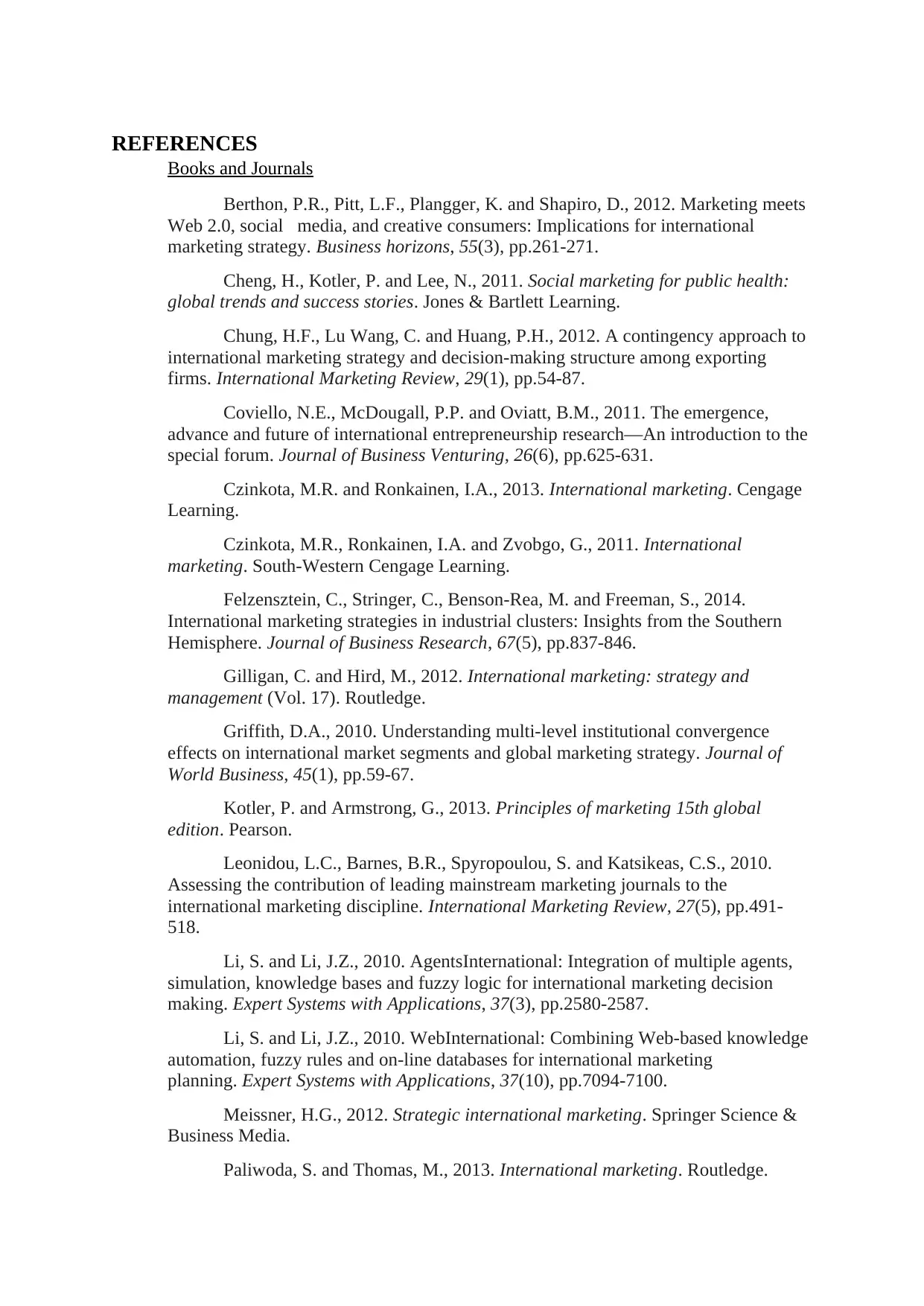
REFERENCES
Books and Journals
Berthon, P.R., Pitt, L.F., Plangger, K. and Shapiro, D., 2012. Marketing meets
Web 2.0, social media, and creative consumers: Implications for international
marketing strategy. Business horizons, 55(3), pp.261-271.
Cheng, H., Kotler, P. and Lee, N., 2011. Social marketing for public health:
global trends and success stories. Jones & Bartlett Learning.
Chung, H.F., Lu Wang, C. and Huang, P.H., 2012. A contingency approach to
international marketing strategy and decision-making structure among exporting
firms. International Marketing Review, 29(1), pp.54-87.
Coviello, N.E., McDougall, P.P. and Oviatt, B.M., 2011. The emergence,
advance and future of international entrepreneurship research—An introduction to the
special forum. Journal of Business Venturing, 26(6), pp.625-631.
Czinkota, M.R. and Ronkainen, I.A., 2013. International marketing. Cengage
Learning.
Czinkota, M.R., Ronkainen, I.A. and Zvobgo, G., 2011. International
marketing. South-Western Cengage Learning.
Felzensztein, C., Stringer, C., Benson-Rea, M. and Freeman, S., 2014.
International marketing strategies in industrial clusters: Insights from the Southern
Hemisphere. Journal of Business Research, 67(5), pp.837-846.
Gilligan, C. and Hird, M., 2012. International marketing: strategy and
management (Vol. 17). Routledge.
Griffith, D.A., 2010. Understanding multi-level institutional convergence
effects on international market segments and global marketing strategy. Journal of
World Business, 45(1), pp.59-67.
Kotler, P. and Armstrong, G., 2013. Principles of marketing 15th global
edition. Pearson.
Leonidou, L.C., Barnes, B.R., Spyropoulou, S. and Katsikeas, C.S., 2010.
Assessing the contribution of leading mainstream marketing journals to the
international marketing discipline. International Marketing Review, 27(5), pp.491-
518.
Li, S. and Li, J.Z., 2010. AgentsInternational: Integration of multiple agents,
simulation, knowledge bases and fuzzy logic for international marketing decision
making. Expert Systems with Applications, 37(3), pp.2580-2587.
Li, S. and Li, J.Z., 2010. WebInternational: Combining Web-based knowledge
automation, fuzzy rules and on-line databases for international marketing
planning. Expert Systems with Applications, 37(10), pp.7094-7100.
Meissner, H.G., 2012. Strategic international marketing. Springer Science &
Business Media.
Paliwoda, S. and Thomas, M., 2013. International marketing. Routledge.
Books and Journals
Berthon, P.R., Pitt, L.F., Plangger, K. and Shapiro, D., 2012. Marketing meets
Web 2.0, social media, and creative consumers: Implications for international
marketing strategy. Business horizons, 55(3), pp.261-271.
Cheng, H., Kotler, P. and Lee, N., 2011. Social marketing for public health:
global trends and success stories. Jones & Bartlett Learning.
Chung, H.F., Lu Wang, C. and Huang, P.H., 2012. A contingency approach to
international marketing strategy and decision-making structure among exporting
firms. International Marketing Review, 29(1), pp.54-87.
Coviello, N.E., McDougall, P.P. and Oviatt, B.M., 2011. The emergence,
advance and future of international entrepreneurship research—An introduction to the
special forum. Journal of Business Venturing, 26(6), pp.625-631.
Czinkota, M.R. and Ronkainen, I.A., 2013. International marketing. Cengage
Learning.
Czinkota, M.R., Ronkainen, I.A. and Zvobgo, G., 2011. International
marketing. South-Western Cengage Learning.
Felzensztein, C., Stringer, C., Benson-Rea, M. and Freeman, S., 2014.
International marketing strategies in industrial clusters: Insights from the Southern
Hemisphere. Journal of Business Research, 67(5), pp.837-846.
Gilligan, C. and Hird, M., 2012. International marketing: strategy and
management (Vol. 17). Routledge.
Griffith, D.A., 2010. Understanding multi-level institutional convergence
effects on international market segments and global marketing strategy. Journal of
World Business, 45(1), pp.59-67.
Kotler, P. and Armstrong, G., 2013. Principles of marketing 15th global
edition. Pearson.
Leonidou, L.C., Barnes, B.R., Spyropoulou, S. and Katsikeas, C.S., 2010.
Assessing the contribution of leading mainstream marketing journals to the
international marketing discipline. International Marketing Review, 27(5), pp.491-
518.
Li, S. and Li, J.Z., 2010. AgentsInternational: Integration of multiple agents,
simulation, knowledge bases and fuzzy logic for international marketing decision
making. Expert Systems with Applications, 37(3), pp.2580-2587.
Li, S. and Li, J.Z., 2010. WebInternational: Combining Web-based knowledge
automation, fuzzy rules and on-line databases for international marketing
planning. Expert Systems with Applications, 37(10), pp.7094-7100.
Meissner, H.G., 2012. Strategic international marketing. Springer Science &
Business Media.
Paliwoda, S. and Thomas, M., 2013. International marketing. Routledge.
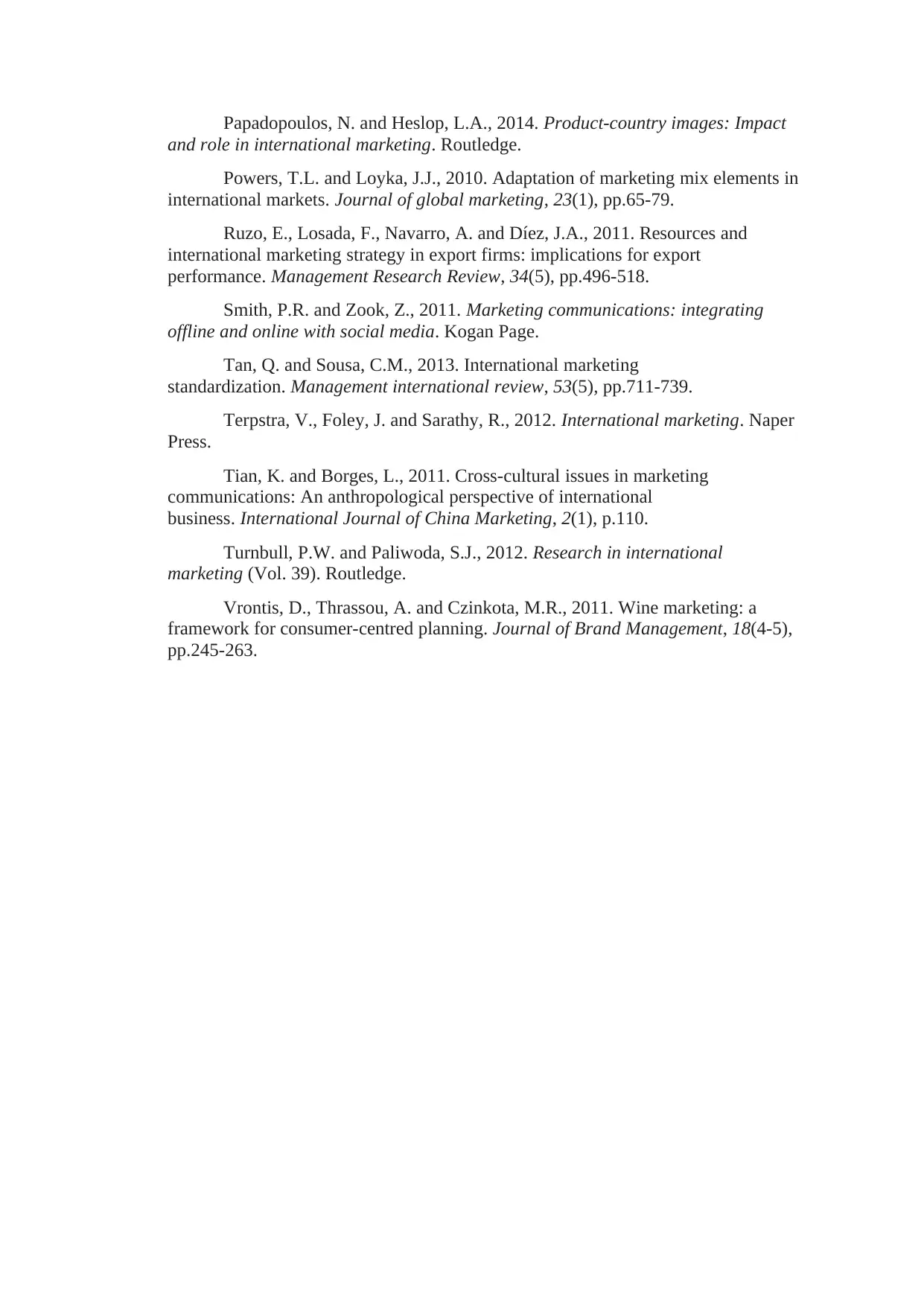
Papadopoulos, N. and Heslop, L.A., 2014. Product-country images: Impact
and role in international marketing. Routledge.
Powers, T.L. and Loyka, J.J., 2010. Adaptation of marketing mix elements in
international markets. Journal of global marketing, 23(1), pp.65-79.
Ruzo, E., Losada, F., Navarro, A. and Díez, J.A., 2011. Resources and
international marketing strategy in export firms: implications for export
performance. Management Research Review, 34(5), pp.496-518.
Smith, P.R. and Zook, Z., 2011. Marketing communications: integrating
offline and online with social media. Kogan Page.
Tan, Q. and Sousa, C.M., 2013. International marketing
standardization. Management international review, 53(5), pp.711-739.
Terpstra, V., Foley, J. and Sarathy, R., 2012. International marketing. Naper
Press.
Tian, K. and Borges, L., 2011. Cross-cultural issues in marketing
communications: An anthropological perspective of international
business. International Journal of China Marketing, 2(1), p.110.
Turnbull, P.W. and Paliwoda, S.J., 2012. Research in international
marketing (Vol. 39). Routledge.
Vrontis, D., Thrassou, A. and Czinkota, M.R., 2011. Wine marketing: a
framework for consumer-centred planning. Journal of Brand Management, 18(4-5),
pp.245-263.
and role in international marketing. Routledge.
Powers, T.L. and Loyka, J.J., 2010. Adaptation of marketing mix elements in
international markets. Journal of global marketing, 23(1), pp.65-79.
Ruzo, E., Losada, F., Navarro, A. and Díez, J.A., 2011. Resources and
international marketing strategy in export firms: implications for export
performance. Management Research Review, 34(5), pp.496-518.
Smith, P.R. and Zook, Z., 2011. Marketing communications: integrating
offline and online with social media. Kogan Page.
Tan, Q. and Sousa, C.M., 2013. International marketing
standardization. Management international review, 53(5), pp.711-739.
Terpstra, V., Foley, J. and Sarathy, R., 2012. International marketing. Naper
Press.
Tian, K. and Borges, L., 2011. Cross-cultural issues in marketing
communications: An anthropological perspective of international
business. International Journal of China Marketing, 2(1), p.110.
Turnbull, P.W. and Paliwoda, S.J., 2012. Research in international
marketing (Vol. 39). Routledge.
Vrontis, D., Thrassou, A. and Czinkota, M.R., 2011. Wine marketing: a
framework for consumer-centred planning. Journal of Brand Management, 18(4-5),
pp.245-263.
1 out of 9
Related Documents
Your All-in-One AI-Powered Toolkit for Academic Success.
+13062052269
info@desklib.com
Available 24*7 on WhatsApp / Email
![[object Object]](/_next/static/media/star-bottom.7253800d.svg)
Unlock your academic potential
© 2024 | Zucol Services PVT LTD | All rights reserved.




